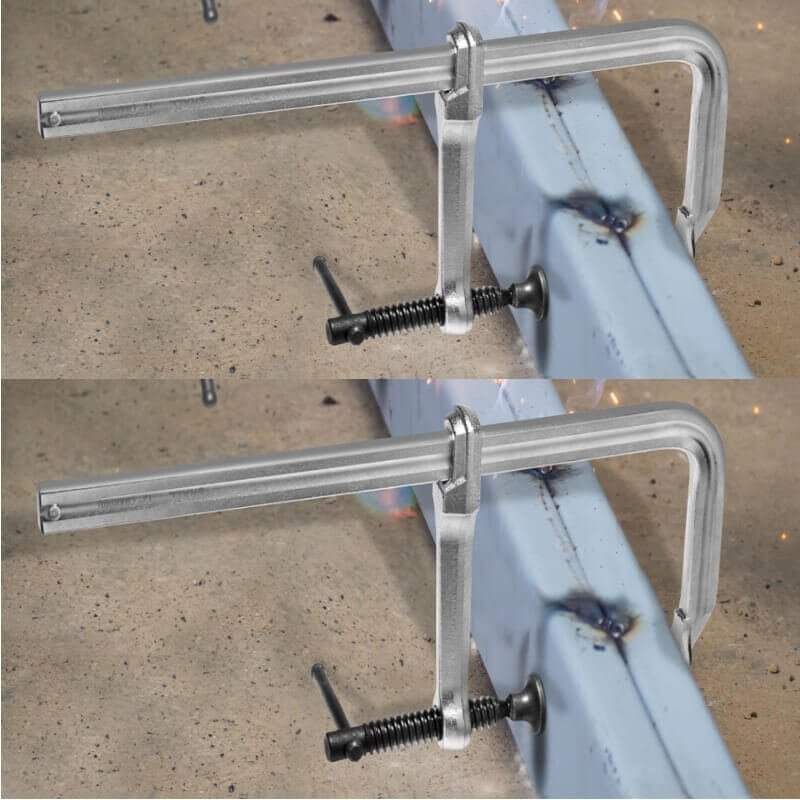Woodworking demands precision, stability, and durability—whether you’re crafting fine furniture, assembling cabinetry, or working on large-scale construction projects.
One of the most essential tools in any woodworker’s arsenal is the heavy-duty F clamp. Known for their robust construction and superior clamping force, these clamps provide unmatched reliability for demanding applications.
In this comprehensive guide, we’ll explore:
-
What makes heavy-duty F clamps indispensable for woodworking
-
Key advantages over standard clamps
-
Top features to look for when choosing the best F clamps
-
Practical applications in various woodworking projects
-
Maintenance tips to extend their lifespan
By the end, you’ll understand why investing in high-quality heavy-duty F clamps is a game-changer for professional woodworkers and hobbyists alike.

What Are Heavy-Duty F Clamps?
F clamps, named for their resemblance to the letter “F,” consist of a fixed jaw, a sliding jaw, and a threaded screw that applies pressure.
Heavy-duty F clamps are built with reinforced materials—such as forged steel or cast iron—to withstand extreme pressure without bending or slipping.
Unlike lightweight clamps, heavy-duty versions offer:
-
Higher clamping force (often exceeding 1,000 lbs)
-
Deeper throat depth for reaching wider workpieces
-
Non-slip pads to prevent marring delicate surfaces
-
Ergonomic handles for comfortable tightening
These features make them ideal for gluing, welding, assembly, and large-scale woodworking projects where standard clamps would fail.
Key Advantages of Heavy-Duty F Clamps
1. Superior Clamping Force for Stronger Holds
Standard clamps may struggle with thick hardwood or large panels, but heavy-duty F clamps provide consistent, high-pressure clamping—ensuring tight joints and seamless glue-ups.
2. Enhanced Durability for Long-Term Use
Constructed from heat-treated steel or ductile iron, these clamps resist warping and bending, even under extreme stress. Unlike cheaper alternatives, they won’t deform after repeated use.
3. Deep Throat Capacity for Larger Projects
Many heavy-duty F clamps feature deep throat depths (6 inches or more), allowing them to secure wide boards, tabletops, and cabinetry with ease.
4. Non-Marring Pads for Surface Protection
Premium models include soft rubber or plastic pads to prevent scratches on finished wood, making them perfect for fine furniture and delicate veneers.
5. Ergonomic Design for Comfortable Use
Extended handles and smooth-threading screws reduce hand fatigue, even during prolonged clamping sessions.
6. Versatility Across Woodworking Applications
From edge gluing panels to securing miters for picture frames, heavy-duty F clamps handle a wide range of tasks with precision.
Top Features to Look for in Heavy-Duty F Clamps
When selecting the best F clamps for woodworking, consider these critical factors:
1. Material & Build Quality
-
Forged steel offers the best strength-to-weight ratio.
-
Cast iron provides rigidity but may be heavier.
-
Avoid cheap aluminum or plastic clamps for heavy-duty work.
2. Clamping Pressure
Look for clamps rated for 1,000 lbs or more for demanding applications.
3. Throat Depth & Maximum Opening
-
Throat depth (reach from bar to screw) should be at least 4-6 inches.
-
Maximum opening (distance between jaws) should accommodate your workpiece.
4. Anti-Slip Features
-
Non-slip pads protect surfaces.
-
Textured handles improve grip when tightening.
5. Screw Mechanism
-
Acme-threaded screws provide smoother, more precise adjustments.
-
Quick-release mechanisms speed up repositioning.
6. Brand Reputation & Warranty
Trusted brands like Bessey, Jorgensen, and Irwin offer reliable warranties and proven durability.
Practical Applications of Heavy-Duty F Clamps in Woodworking
1. Panel Gluing & Tabletop Assembly
Heavy-duty F clamps ensure even pressure distribution, preventing gaps in glued joints.
2. Cabinet & Furniture Construction
Their deep reach makes them ideal for securing carcasses, face frames, and door assemblies.
3. Mitre Joint Clamping
Perfect for picture frames and trim work, keeping corners tightly aligned.
4. Bent Lamination Projects
The high clamping force helps hold curved laminations in place during glue drying.
5. Workbench & Jig Securing
Use them to fix workpieces to benches or hold jigs steady during machining.
Maintenance Tips for Long-Lasting Performance
To maximize the lifespan of your heavy-duty F clamps:
✔ Clean after each use – Remove sawdust and glue residue.
✔ Lubricate the screw threads – Use light machine oil for smooth operation.
✔ Store properly – Hang or rack clamps to prevent warping.
✔ Inspect for damage – Check for bent bars or stripped screws before use.
Conclusion: Why Every Woodworker Needs Heavy-Duty F Clamps
Whether you’re a professional carpenter or a DIY enthusiast, heavy-duty F clamps are an indispensable tool for achieving strong, precise, and gap-free joints.
Their unmatched clamping force, durability, and versatility make them a must-have for any serious woodworking shop.
Invest in high-quality F clamps today—your projects will thank you!
FAQs
Q: How do heavy-duty F clamps differ from bar clamps?
A: While both provide strong clamping, F clamps have a fixed jaw and sliding mechanism, making them more compact and easier to use in tight spaces.
Q: Can I use F clamps for metalworking?
A: Yes! Many heavy-duty F clamps are suitable for welding and metal fabrication due to their high-pressure resistance.
Q: What’s the ideal number of clamps for woodworking?
A: For large glue-ups (like tabletops), at least 4-6 clamps are recommended to ensure even pressure distribution.
Q: Are there lightweight alternatives for delicate work?
A: For fine woodworking, consider parallel clamps or quick-release clamps, which offer precision without excessive force.
Heavy-Duty F Clamps for Woodworking,By understanding the benefits and applications of heavy-duty F clamps, you can elevate your woodworking projects with professional-grade stability and strength. Choose the right clamps, maintain them well, and enjoy flawless results every time!
